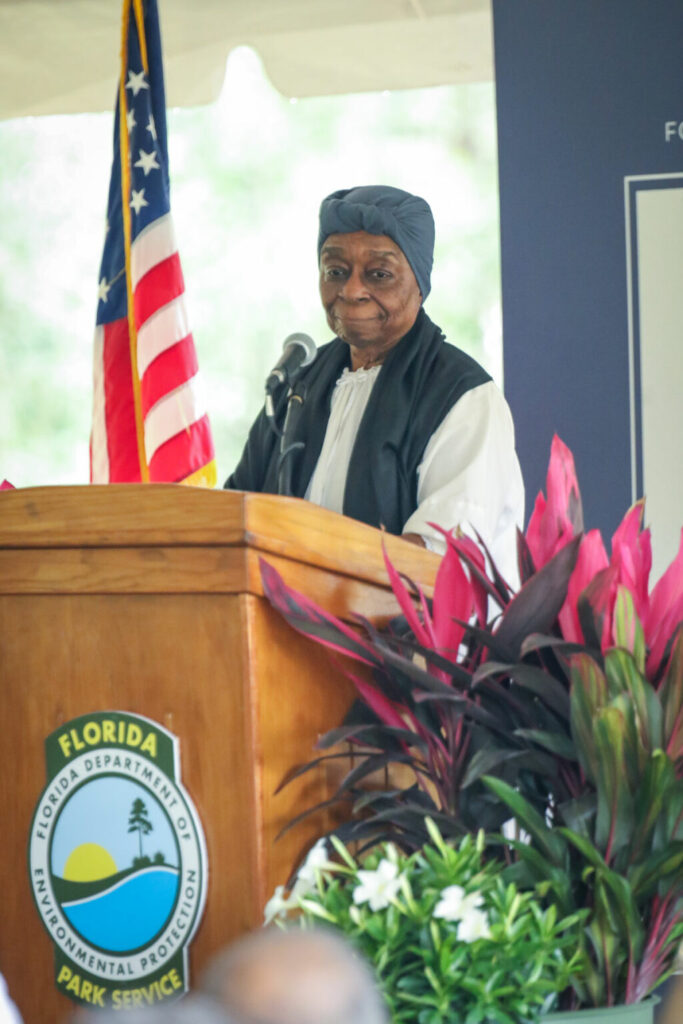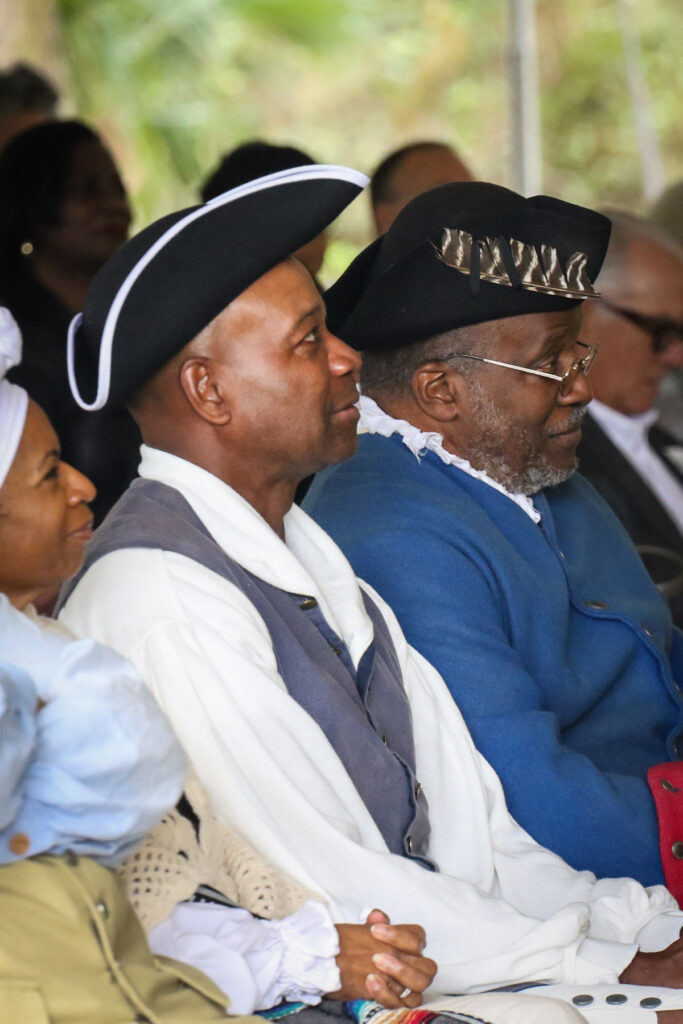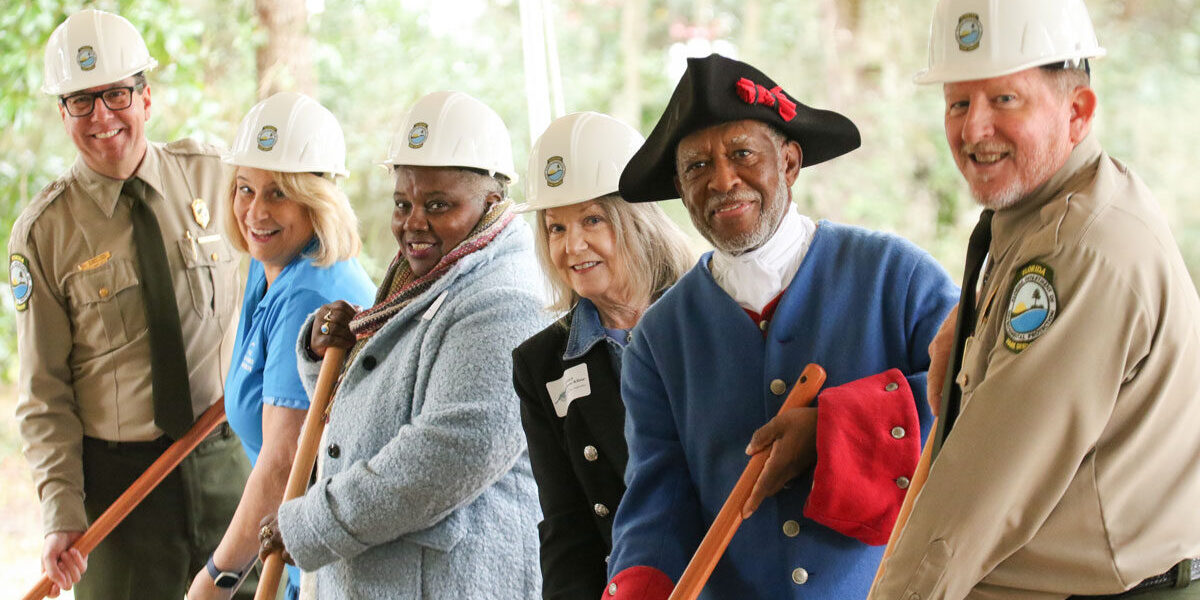Written by Teddy Regis of Evolve Magazine
“Fort Mose is more than the building. Fort Mose represents the people…a diverse group of men, women and children who came to this place to carve a life for themselves out of this wilderness.” -Alma Melvin, Fort Mose Historical Society Re-enactor
Jan. 19, 2024, will go down in St. Augustine’s modern history as a momentous day decades in the making. Dignitaries, including journalists, historians, archaeologists and the like, came together beneath a tent and mist-laden skies to commemorate a groundbreaking and ribbon cutting at Fort Mose – the first legally sanctioned free Black settlement in what is now the United States.
From 1687 to 1763, the formerly enslaved Africans who journeyed some 377 miles enjoyed freedom. But after Spain ceded all of La Florida to England in 1763, the residents of Fort Mose once again faced enslavement. The fort gradually succumbed to the Florida marsh, and the accompanying legacy of those courageous Africans fell into relative obscurity, its story often left untold. Some of this obscurity can be tied to a language barrier. Vanderbilt University professor of history – Dr. Jean Landers* was present for the groundbreaking. She shared this insight: “All the [source] material is in Spanish.” So, the added step of translation may have contributed to limited notoriety until now. With the help of Dr. Landers’ efforts, the story of Fort Mose has been published in college textbooks.
The existing Fort Mose museum, currently situated near St. Augustine’s city gates, has long been the site of many field trips and touristic visits. But now, at long last, visitors will no longer depart from Fort Mose asking, “Where is the fort?” A tribute to the freedom seekers will be built – joining the likes of Fort Matanzas, the Castillo de San Marcos monument and scores of historic sites present in the state of Florida.
A sense of alignment, harmony and serendipity permeated the air on Jan. 19. As Charles Ellis – founding member and president of the Fort Mose Historical Society, pointed out from the podium, “18 years ago, […] we broke ground for the museum, and it’s ironic that here we are…today…in [the] process of breaking ground for another monument.” Decked out in full 18th-century military regalia, Ellis went on to emphatically remind those in attendance that “this groundbreaking is a story that needs to be told.” He harkened back to the late Otis Mason, who once also served as president of the Fort Mose Historical Society. The former superintendent of St. Johns County schools was among those who had a fervent desire to see the story of the courageous men and women who underwent a most perilous journey – zealous for a return to freedom no matter the consequences. Ellis reviewed some of the developments that have helped the reconstruction project come so far. In 2012, the historical society conducted a planning and brainstorming session in which architectural renderings were drafted. Then came a number of fundraising initiatives with the help of grants and local business sponsors. Many of those sponsors came to honor the groundbreaking event. The historical society fostered key partnerships with the Florida Park Foundation, the local amphitheater and County Commissioners.
 Also on hand for the tribute was distinguished research curator of archaeology and adjunct professor of anthropology and history at UF’s Florida Museum of Natural History – Kathleen Deagan. Since 1972, she has performed excavations in St. Augustine. Her work included the critical identification of Fort Mose itself. While addressing the audience, Deagan shared the account of Florida legislator Bill Clark’s visit to St. Augustine, during which time he learned about Fort Mose. “He became really intrigued, and we got in touch and began talking…that was the genesis of some of the archaeology that was done, and we were able, through the University of Florida, to work on the site for several seasons,” Deagan explained. She went on to acknowledge the work of Darcie McMahon (also on hand for the groundbreaking), who is director of exhibits and public programs at the Florida Museum of Natural History. McMahon oversaw an exhibit called “Colonial America’s Black Fortress of Freedom.” Deagan shared that it toured for 11 years and was likely seen by upwards of one million people. She went on to relate that “curiously, it still didn’t enter into the popular consciousness” in terms of what many consider to be American History. “I think what we’re doing here today is the thing that will bring that into the much more public popular broad context of American history.”
Also on hand for the tribute was distinguished research curator of archaeology and adjunct professor of anthropology and history at UF’s Florida Museum of Natural History – Kathleen Deagan. Since 1972, she has performed excavations in St. Augustine. Her work included the critical identification of Fort Mose itself. While addressing the audience, Deagan shared the account of Florida legislator Bill Clark’s visit to St. Augustine, during which time he learned about Fort Mose. “He became really intrigued, and we got in touch and began talking…that was the genesis of some of the archaeology that was done, and we were able, through the University of Florida, to work on the site for several seasons,” Deagan explained. She went on to acknowledge the work of Darcie McMahon (also on hand for the groundbreaking), who is director of exhibits and public programs at the Florida Museum of Natural History. McMahon oversaw an exhibit called “Colonial America’s Black Fortress of Freedom.” Deagan shared that it toured for 11 years and was likely seen by upwards of one million people. She went on to relate that “curiously, it still didn’t enter into the popular consciousness” in terms of what many consider to be American History. “I think what we’re doing here today is the thing that will bring that into the much more public popular broad context of American history.”
We opened today with a quote from historical society re-enactor Alma Melvin. She had much insight to share from the podium, donning a house dress and bonnet. Melvin took care to shine a light on the women of Fort Mose, who played a vital role in the story. As she reminded the crowd, “the courageous women, the women that struggled to get here…had to till the land…plant the harvest…raise the children and cook and clean…they made a home.”
The Jan. 19 groundbreaking was ahead of a slew of events, including a vibrant jazz and blues series. From Feb. 8-17, performers including Common, Wynton Marsalis and The New Jazz Underground took the stage. February also featured a signature event called the “Flight to Freedom” re-enactment. This three-day festival at Fort Mose State Park takes thousands of visitors on immersive guided tours of the Flight to Freedom Trails led by re-enactors. The stirring account of the freedom seekers’ perilous journey from enslavement on the Carolina plantations to freedom in Spanish Florida leaves a memorable mark on attendees. With the forthcoming addition of the reconstructed fort, we can expect an increase in average visitors.
As Mose’s mist began to dissipate on the morning of Jan. 19, the event closed with the re-enactment of a cannon firing. The militia muster stood poised in their blue and red militia gear. After following the proper orders, those in attendance were warned to cover their ears. Just like that, the tribute went out with a resounding bang – one that will ring out and echo perpetually in heart and mind.






